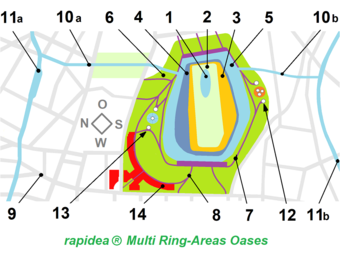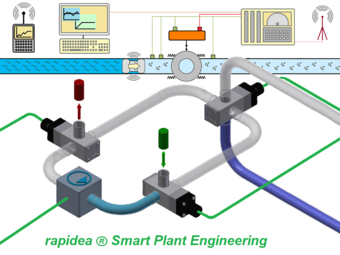ENVIRONMENTALLY FRIENDLY AND SUSTAINABLE TECHNOLOGIES

The essential interrelationships within the ecological system are now known to humanity. This knowledge about the interplay between flora and fauna, the effects and behavior of natural phenomena such as tectonics, the oceans, and the global climate, is compiled in databases and accessible to everyone, including via the internet. How the ecological system and the global climate react to changes is known and predictable to humanity.
Despite knowledge of the interrelationships within the ecological system and despite experience with the behavior of the ecological system, humanity continues to introduce a multitude of technologies and initiate a multitude of measures to which the ecological system inevitably reacts according to its known rules. Many of these reactions are detrimental to flora, fauna, tectonics, the global climate, and the Earth as a habitat.
This contradiction, namely, on the one hand, the knowledge of the responsiveness of the ecological system and, on the other hand, humankind's actions with their inevitably negative consequences for the ecological system and the damage to the Earth's habitat, must be reconsidered and readjusted toward environmentally friendly actions, environmentally friendly technologies, and environmentally friendly strategies. Only in this way will it be possible for the ecological system to regenerate and the global climate to stabilize optimally.
To successfully pursue this innovative and forward-looking path, active and consciously environmentally friendly action must also reconsider previously underlying values, ideas, rules, and measures that have clearly not led to satisfactory solutions or have only led to detrimental changes in the ecological system.
ANIMATION TO THE ENVIRONMENTALLY FRIENDLY TECHNOLOGIES OF THE MULTI RING-AREAS OASES
ANIMATION TO THE ENVIRONMENTALLY FRIENDLY TECHNOLOGIES OF THE SMART PLANT ENGINEERING
ENVIRONMENTALLY FRIENDLY AND SUSTAINABLE TECHNOLOGY OF THE MULTI RING-AREAS OASES

A particularly environmentally friendly and forward-looking innovation is the technology and strategy for the so-called Multi Ring-Areas Oases. Multi Ring-Areas Oases are a sustainable contribution to the regeneration of the ecological system and to climate protection. Multi Ring-Areas Oases also fulfill general social demands for the utilization of land (see also: rapidea ® Multi Ring-Areas Oases).
The principle of these Multi Ring-Areas Oases is explained below using the planning example of Tempelhofer Feld in Berlin:
A lake 1 is planned in the core area, which is enclosed by a natural area 2 designed as a ring. Both together are intended to form a biotope in which some of the native flora and fauna can develop undisturbed by encroachment. To protect against external interference, this biotope is to be enclosed by additional ring areas, namely a ring area with above-ground and underground high-bay plantations 3, which primarily offer cultivation opportunities for regionally sourced fruit, vegetables, and other plants; another ring area with above-ground and underground high-bay aquariums 4, which primarily serve to raise edible fish, mussels, etc. in symbiosis with the high-bay plantations 3; a ring area designed as a navigable canal 5; and another ring area designed as a leisure park 6.
The leisure park 6 is equipped with, among other things, hiking trails 7, connecting paths 8 to the surrounding infrastructure, an underground building complex with an above-ground integrated well system 13, and an underground building complex with an above-ground integrated climbing tower 12.
Under the glass dome of fountain 13 and within the climbing towers 12 are light guide systems that channel natural daylight into the underground event, exhibition, and recreational spaces.
The circular canal 5 is to be connected to the city of Berlin's existing waterways 11a and 11b via two canals 10a and 10b. These canals 10a and 10b will run through the city via disused canals and railway tracks, parks, and rarely used streets.
If sufficient space is available for such environmentally friendly Multi Ring-Areas Oases, such as outside urban areas or in desert regions, these can be supplemented with additional ring areas, which could include residential areas, additional infrastructure, solar fields, energy storage facilities, wind turbines, solar power plants, industrial facilities, commercial enterprises, animal husbandry, and agriculture.
ANIMATION TO THE ENVIRONMENTALLY FRIENDLY TECHNOLOGIES OF THE MULTI RING-AREAS OASES
TECHNOLOGIE OF THE SMART PLANT ENGINEERING

In Smart Plant Engineering, which is already relatively environmentally friendly in principle, all components are logically interconnected. The monitoring of systems and processes is fully automated. The systems self-adjust and automatically transmit notifications or alarms to people. These systems can detect an impending emergency and preemptively switch themselves into a kind of safety mode. Process sequences can be modified in an emergency to ensure safety, preventing damage to the system and its surroundings. Worn-out units and components can be replaced by the system itself, and faulty software can be readjusted and outdated software replaced – all during ongoing operation or without significant interruption to operations.
Innovative technologies developed based on the many advantages of Smart Plant Engineering are also particularly environmentally friendly, due, among other things, to the low risk of unexpected failures and unexpected disasters that harm nature.
ANIMATION TO THE ENVIRONMENTALLY FRIENDLY TECHNOLOGIES OF THE SMART PLANT ENGINEERING
